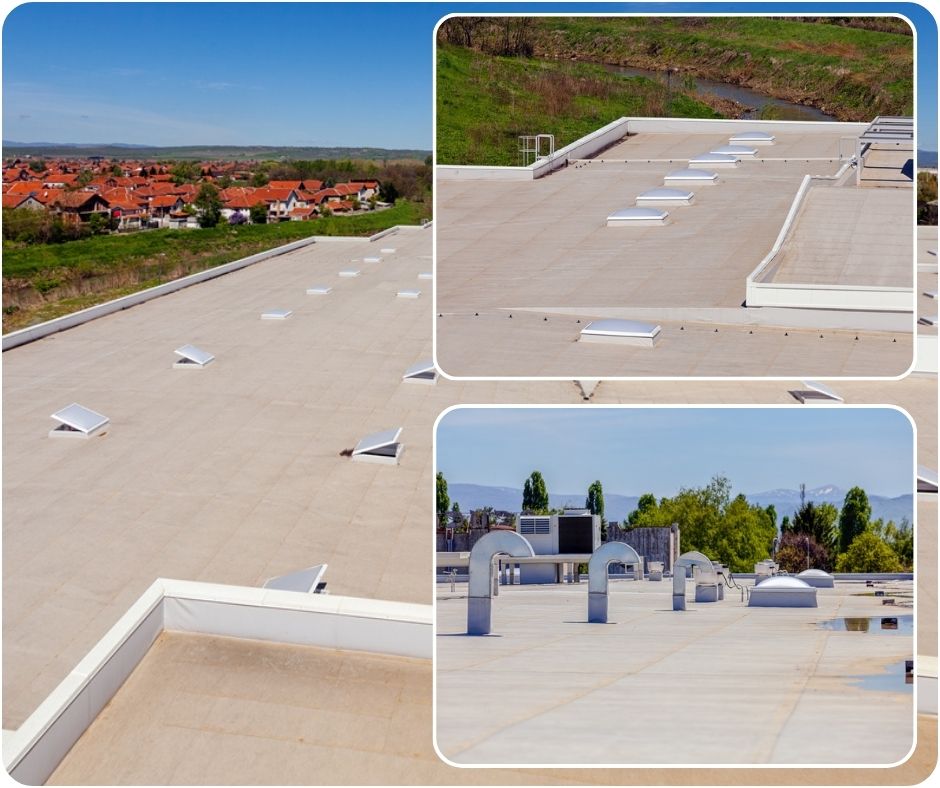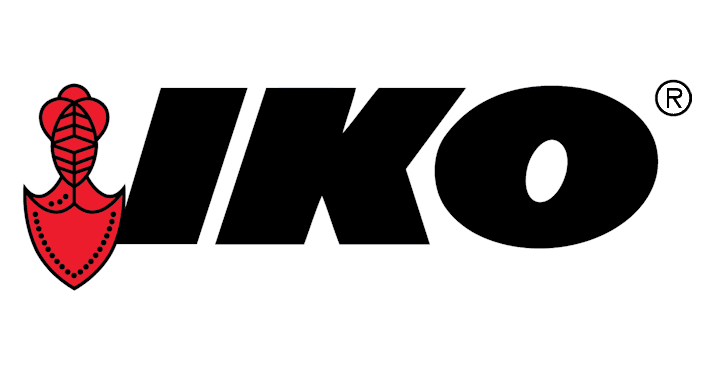How Does the Drainage System Work On a Flat Roof?
Flat roofs offer a sleek, contemporary look and are often chosen for their cost-effectiveness and ease of installation. Despite their name, flat roofs are not entirely flat; they have a slight slope to facilitate water drainage. Proper drainage is essential to prevent water pooling, which can lead to leaks, structural damage, and reduced roof lifespan. This article delves into the intricacies of flat roof drainage systems, explaining how they work and why they are vital for maintaining the integrity of the roof.
How Flat Roof Drainage Systems Work: Your Ultimate Guide
Flat roofs offer a sleek, contemporary look and are often chosen for their cost-effectiveness and ease of installation. Despite their name, flat roofs are not entirely flat; they have a slight slope to facilitate water drainage. Proper drainage is essential to prevent water pooling, which can lead to leaks, structural damage, and reduced roof lifespan. This article delves into the intricacies of flat roof drainage systems, explaining how they work and why they are vital for maintaining the integrity of the roof.
The Importance of Proper Drainage on Flat Roofs
Preventing Water Accumulation
One of the primary concerns with flat roofs is water accumulation. Unlike pitched roofs, where gravity naturally directs water off the surface, flat roofs require a well-designed drainage system to manage water flow. Without proper drainage, water can pool on the roof, leading to leaks, mold growth, and structural damage. Effective drainage systems ensure that water is quickly and efficiently removed from the roof surface, protecting the building and its occupants.
Components of a Flat Roof Drainage System
A flat roof drainage system typically consists of several key components, each playing a crucial role in managing water flow. These components include:
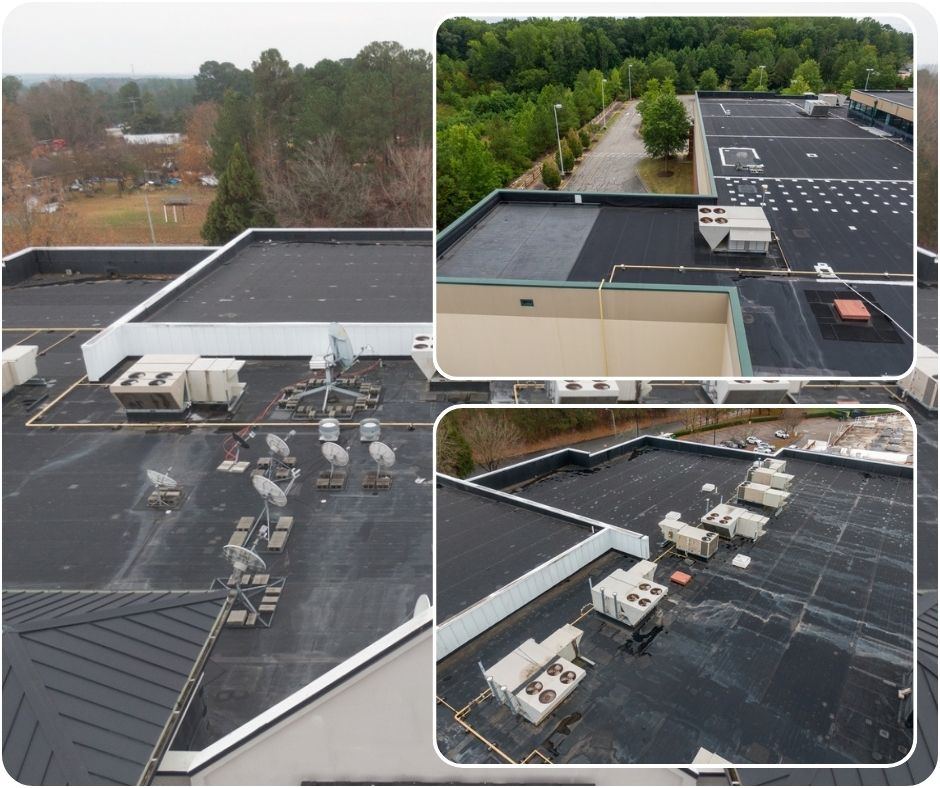
Although flat roofs appear level, they are designed with a slight slope (usually between 1/8 to 1/4 inch per foot) to direct water towards drainage points.
Roof drains are strategically placed to collect water and channel it away from the roof. These drains can be internal or external, depending on the building’s design.
Scuppers are openings in the parapet walls that allow water to drain off the roof. They are often used in conjunction with downspouts to direct water away from the building.
Gutters and downspouts are essential for directing water away from the roof and foundation. They collect water from the roof surface and channel it to the ground, preventing water damage to the building’s structure.
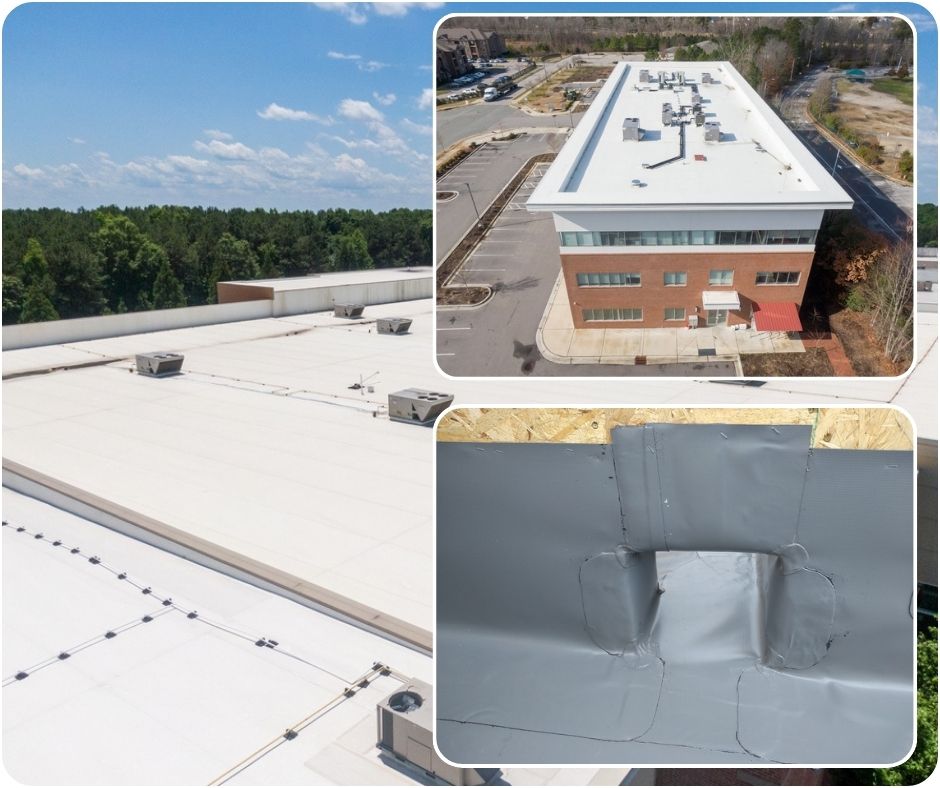
No Water Roofing: Your Trusted Partner
Expertise and Quality You Can Rely On: At No Water Roofing, we understand the importance of a well-maintained roof. Our team of experienced professionals is dedicated to providing top-notch roof repair and inspection services for both residential and commercial properties. With our thorough inspections and high-quality repairs, we ensure that your roof remains in excellent condition, protecting your investment and ensuring the safety of your property.
For more information on our roof repair and inspection services, visit our website at No Water Roofing. Schedule an inspection today and experience the peace of mind that comes with knowing your roof is in expert hands.
How Flat Roof Drainage Systems Work
The slight slope of a flat roof is critical for effective drainage. This slope ensures that water flows towards the designated drainage points, preventing pooling on the roof surface. The slope is typically created during the construction of the roof, using tapered insulation or a sloped substrate. By directing water towards drains, scuppers, or gutters, the slope helps maintain the roof’s integrity and prevents water-related issues.
Flat roofs can utilize either internal or external drains, depending on the building’s design and drainage requirements. Internal drains are installed within the roof structure and connected to the building’s plumbing system. These drains collect water from the roof surface and channel it through pipes to the ground. Internal drains are often preferred for their aesthetic appeal and ability to handle large volumes of water.
External drains, on the other hand, are installed on the roof’s exterior and connected to downspouts. These drains collect water and direct it away from the building’s foundation. External drains are typically easier to install and maintain, making them a popular choice for many flat roofs.
Scuppers are openings in the parapet walls that allow water to drain off the roof. They are often used in conjunction with downspouts to direct water away from the building. Scuppers are particularly effective in managing large volumes of water, as they provide an additional drainage point for the roof. Downspouts, connected to scuppers or gutters, channel water from the roof to the ground, preventing water damage to the building’s structure.
The slight slope of a flat roof is critical for effective drainage. This slope ensures that water flows towards the designated drainage points, preventing pooling on the roof surface. The slope is typically created during the construction of the roof, using tapered insulation or a sloped substrate. By directing water towards drains, scuppers, or gutters, the slope helps maintain the roof’s integrity and prevents water-related issues.
Flat roofs can utilize either internal or external drains, depending on the building’s design and drainage requirements. Internal drains are installed within the roof structure and connected to the building’s plumbing system. These drains collect water from the roof surface and channel it through pipes to the ground. Internal drains are often preferred for their aesthetic appeal and ability to handle large volumes of water.
External drains, on the other hand, are installed on the roof’s exterior and connected to downspouts. These drains collect water and direct it away from the building’s foundation. External drains are typically easier to install and maintain, making them a popular choice for many flat roofs.
Scuppers are openings in the parapet walls that allow water to drain off the roof. They are often used in conjunction with downspouts to direct water away from the building. Scuppers are particularly effective in managing large volumes of water, as they provide an additional drainage point for the roof. Downspouts, connected to scuppers or gutters, channel water from the roof to the ground, preventing water damage to the building’s structure.
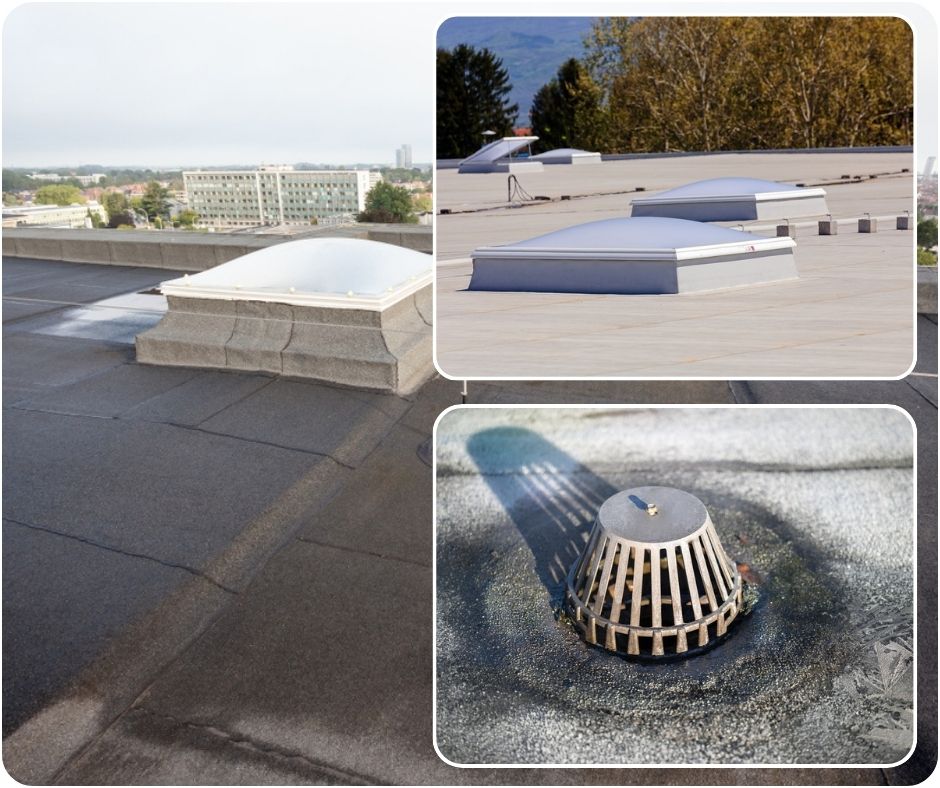
Maintenance of Flat Roof Drainage Systems
Regular Inspections
Regular inspections are essential for maintaining the effectiveness of flat roof drainage systems. Property owners should inspect their roofs at least twice a year, ideally in the spring and fall, to identify any potential issues. During inspections, check for debris, blockages, and signs of wear and tear. Addressing these issues promptly can prevent more significant problems and extend the lifespan of the roof.
Cleaning and Debris Removal
Debris, such as leaves, branches, and dirt, can accumulate on flat roofs and obstruct drainage systems. Regular cleaning is crucial to ensure that drains, scuppers, and gutters remain clear and functional. Property owners can use a broom or leaf blower to remove debris from the roof surface. Additionally, cleaning gutters and downspouts helps prevent blockages and ensures efficient water flow.
Repairing Damage
Over time, flat roof drainage systems can experience wear and tear, leading to leaks and other issues. Promptly repairing any damage is essential to maintain the roof’s integrity. Common repairs include patching leaks, replacing damaged drains, and sealing cracks in the roof surface. Hiring a professional roofing contractor can ensure that repairs are done correctly and effectively.
Benefits of Proper Flat Roof Drainage
The slight slope of a flat roof is critical for effective drainage. This slope ensures that water flows towards the designated drainage points, preventing pooling on the roof surface. The slope is typically created during the construction of the roof, using tapered insulation or a sloped substrate. By directing water towards drains, scuppers, or gutters, the slope helps maintain the roof’s integrity and prevents water-related issues.
Proper drainage is crucial for prolonging the lifespan of flat roofs. By preventing water accumulation and related issues, effective drainage systems help maintain the roof’s structural integrity. Regular maintenance and prompt repairs further contribute to the roof’s longevity, ensuring that it remains in good condition for years to come.
Effective flat roof drainage systems enhance building safety by preventing water damage and related issues. Water accumulation can lead to leaks, mold growth, and structural damage, posing risks to the building and its occupants. By ensuring proper drainage, property owners can protect their buildings and create a safe environment for residents and visitors.
Proper drainage can also improve the energy efficiency of flat roofs. Water accumulation can increase the roof’s weight and reduce its insulating properties, leading to higher energy consumption. By maintaining effective drainage systems, property owners can ensure that their roofs remain energy-efficient, reducing heating and cooling costs.
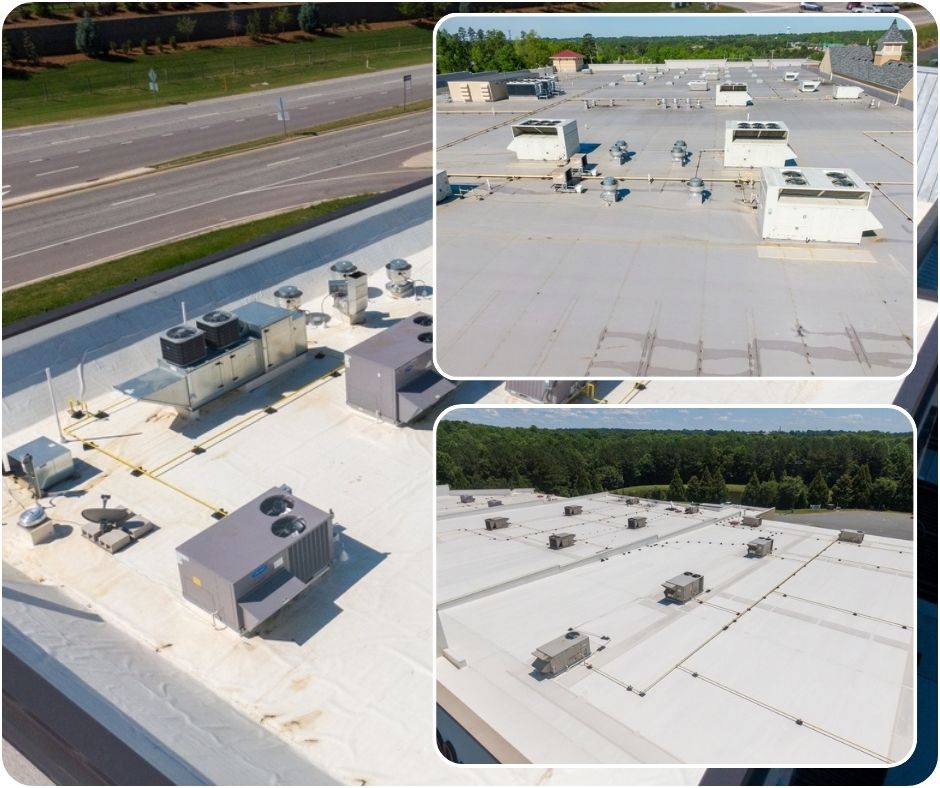
Flat roofs offer numerous benefits, from their modern aesthetic to their cost-effectiveness. However, proper drainage is essential to maintain their integrity and prevent water-related issues. By understanding how flat roof drainage systems work and investing in regular maintenance, property owners can ensure their roofs remain in excellent condition for years to come. Don’t wait until problems arise – take proactive steps to protect your flat roof and enjoy the peace of mind that comes with a well-maintained drainage system.
Ensure your flat roof remains in optimal condition by investing in a well-designed drainage system. Regular maintenance and prompt repairs are essential for preventing water-related issues and prolonging the roof’s lifespan. Contact a professional roofing contractor to inspect your flat roof and recommend the best drainage solutions for your property.
At No Water Roofing, we’re committed to staying at the forefront of innovation in the roofing industry. To achieve this, we’ve established partnerships with some of the world’s leading material suppliers and technology providers. Our network of trusted vendors includes industry giants like Soprema, Carlisle SynTec Systems, BP, DeckRite, Vipeq, and IKO, among others. These partnerships enable us to bring the latest and greatest products and technologies to our clients, ensuring that our work is always of the highest quality and meets the most stringent standards.
From cutting-edge waterproofing solutions to advanced roofing materials and innovative installation techniques, we’re constantly seeking out the best in the industry to incorporate into our work. By working closely with our suppliers and staying up-to-date on the latest developments, we’re able to offer our clients unparalleled expertise and a wide range of options to suit their unique needs and goals.
Whether you’re looking to upgrade your existing roofing system, address water damage, or simply want to ensure your building is protected from the elements, we’re here to help. With our access to the best products and technologies on the market, we’re confident that we can deliver exceptional results that meet your needs and exceed your expectations.

